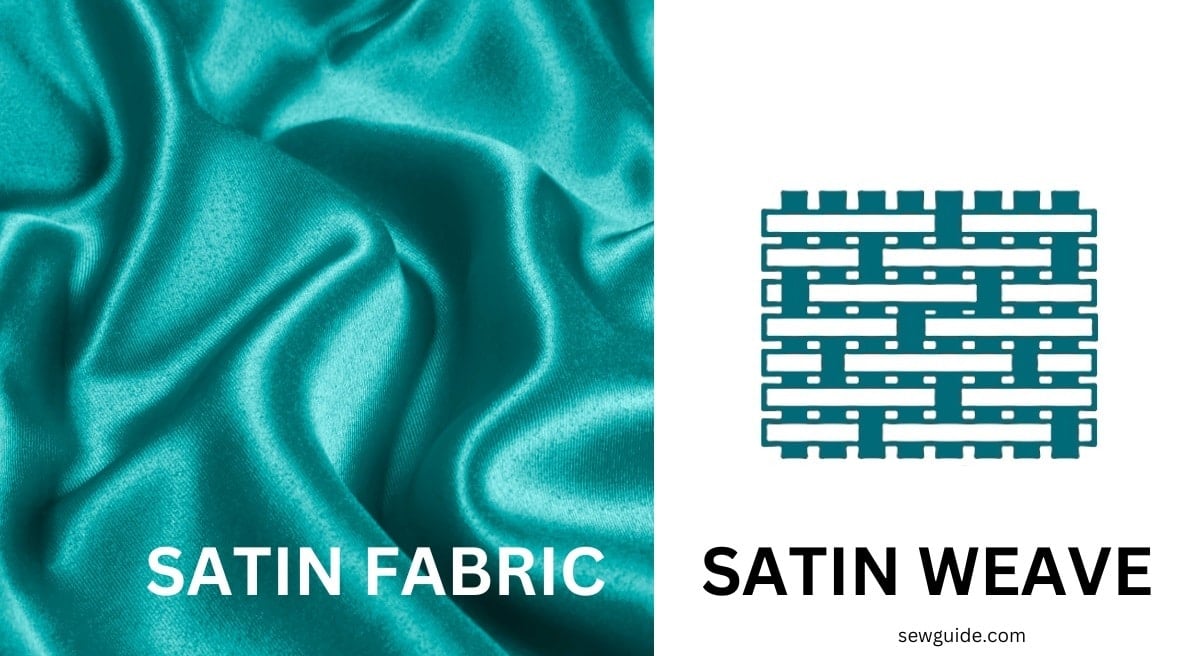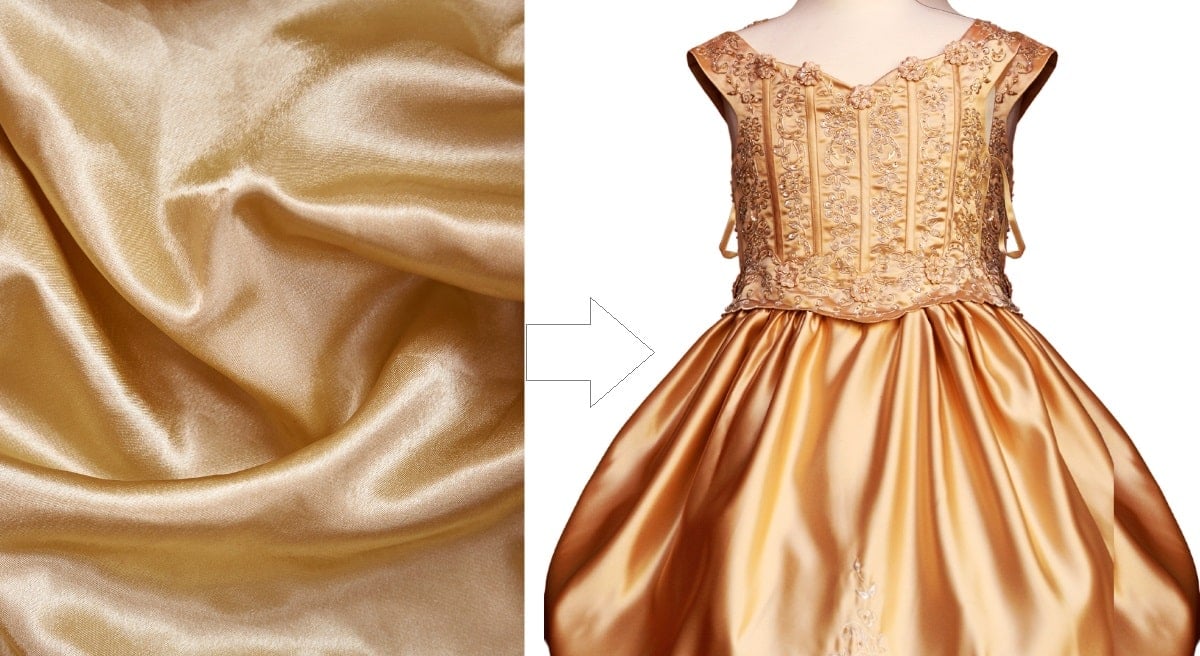
The sound of Satin brings to mind glossiness, luxury, and softness. There is no end to beautiful things being made and sewn with Satin fabric. But do you know that a lot of different fabrics are called Satin because of the weave and their texture?. There
What is Satin fabric
- What is Satin fabric
- Satin fabric & Satin weave
- What does satin feel like?
- Silk satin vs. Satin
- What are the different types of satin fabric?
- Antique satin
- Acetate satin
- Baronet satin
- Canton satin
- Charmeuse
- Duchess satin
- Crepe back satin
- Hammered satin
- Messaline
- Panne satin
- Ribbed satin
- Slipper satin
- Characteristics of Satin
- Uses of Satin fabric
- What are the problems of Satin fabric as a dressmaking fabric?
- Which is a best satin fabric for wedding gowns?
- Is satin cotton?
- Name of a high end satin fabric
- What is the difference between satin crepe and crepe backed satin?
- What is Satin twill fabric?
Satin is a soft fabric with a silky smooth texture. It is made of fibers of silk, cotton, wool, and even synthetic fibers like polyester and acetate and is woven in a particular fabric weave called the satin weave.
Satin fabric & Satin weave

All satin fabrics have a satin weave, but not all satin weave fabrics are satin.
Satin is a very ambiguous name for this fabric because many fabrics can be called that. I always thought of satin as a certain fabric just like cotton and silk. Now I know it is not just that.
Satin refers to the weave, which makes the fabric, that is also known as satin.
But not all satin weave fabrics are satin. Many fabrics made of satin weave may not be satin. Examples are Sateen – This is a cotton fabric woven in satin weave; Venetian cloth – This is a woolen cloth made in satin weave.
In a satin weave, four or more weft threads will pass over and under one warp thread, or vice versa. These weft threads will be ‘floating’ on the fabric surface, giving the fabric its smooth, shiny surface.
What does satin feel like?
Satin feels smooth, silky, and luxurious on the surface on the right side. But only on the right side – satin fabrics often have a distinct right side and wrong side. The back of most satin fabrics are less shiny and may have a duller finish. Some satin may have a rougher matt back. Crepe backed satin has a crinkly back.
Silk satin vs. Satin
Many people confuse between silk and satin. But not all silks are satin, and not all satins are made of silk.
☝ Silk is a natural product, but Satin maynot be. Many popular satins are made of synthetic fibers.
☝ There is silk satin with all the softness that satin weave entails, but not all silks are soft. Some silks like tusser silk may be slightly coarse in its feel.
☝ Satin may be more affordable than silk. Once upon a time, the satin fabric was made only with silk fibers but not anymore. Addition of synthetic fibers like nylon has made satin affordable to people like me.
Basically speaking, Satin gets its glossiness from its weave rather than the fibers. The weave of satin with minimum interlacing between fibers creates the famous smoothness and glossiness.
What are the different types of satin fabric?
Satin is available in many weights, as well as qualities. Many different types of satin are available in shops – with some glaring and some subtle differences.
Antique satin
Antique satin is a heavy, dull lustrous satin fabric; this fabric is woven with uneven (slubbed) yarns resulting in a textured finish on the front. The back side is satin smooth. It is a reversible fabric.
Acetate satin
Acetate satin is the most common inexpensive satin available in shops – this is a medium-weight fabric usually used to make linings for evening gowns, and also for cheap gowns and dresses.
Baronet satin
Baronet satin is a very smooth satin found in many bright colors. It is very lustrous. It has Rayon yarn in the weave.
Canton satin
Canton satin is a soft, but heavy satin with a ribbed texture (crepe finish) in the back.
Charmeuse
Charmeuse is a lightweight satin which drapes very well; it is very clingy and has an attractive luster on the surface (but dull on the backside).
Duchess satin
Duchess satin is a heavy stiff satin with not much shine. It is used in making bridal wear.
Crepe back satin
Crepe back stin has one side satin and one side crepe, so that it can be used with either side.
Hammered satin
Hammered satin is a textured satin.
Messaline
Messaline is a lightweight satin.
Panne satin
Panne satin is a stiff satin which is very glossy.
Ribbed satin
Ribbed satin is a satin with thin ribs on the surface.
Slipper satin
Slipper satin is a lightweight Satin with a cotton back.
Characteristics of Satin
✔ The most important characteristic of satin is its ultra smoothness on one side. The fabric has a dull back.
✔ Satin is a luxurious-looking fabric. Many evening gowns and wedding gowns are made in Satin because of their glossy looks. It can look more expensive than it is, because of the smooth, silky look.
Uses of Satin fabric

Satin is one of the most commonly used fabrics to make gowns and dresses.
✔ Good weight satin fabrics in silk-like Duchess Satin is popularly used to make couture wedding and evening gowns.
✔ Acetate satin fabrics can be seen in inexpensive evening gowns, costumes etc.
✔ Other satin fabrics are used for a variety of uses, including draperies, home furnishing, flower making etc.
✔ Jackets and coats are usually lined with satin made of synthetic materials.
What are the problems of Satin fabric as a dressmaking fabric?
♦ Generally, Satin is drapey, but Not all satin fabric is drapable. There is very stiff Satin, so when buying fabric online, check the drapability of the particular Satin you are buying. The smoothness also may differ. If you are making a dress, get a swatch and compare smoothness and drape before buying.
♦ Water staining is a characteristic of satin cloth. Hence if you use the fabric to sew dresses in summer you should be prepared for some staining where you sweat. One problem many faces with satin is the appearance of water spots. Do not use water spays when ironing satin. It is always better to press satin from the wrong side.
♦ The fabric cut edges fray a lot.
♦ Satin is not your everyday fabric. If you want a hardwearing fabric you had better settle for cotton. If you want to sew clothes with Satin you had better take care of it the right way. Most satin clothes come with the label – Dryclean only. The smooth texture of satin can easily be marred with wear and tear and careless washing.
If there are designs embossed on satin, these designs may fade with constant wear.
♦ The surface is prone to snag, so it is difficult to maintain the soft, smooth surface of Satin – so you can say it is high maintenance.
♦ Some inexpensive satin may have fragmented and small fibers on the surface which look unsightly, especially after a wash. Handwashing the satin clothes inside out may prevent this from happening. Abrasion with other clothes in the washing machine can change the smooth texture of the fabric.
♦ Another problem involves cheap quality satin fabrics. They fray like mad, and come apart at the seams. Most needles make big holes on these weakly woven fabrics. This can come open any time with the slightest tension.
Related posts : Silk vs satin.; Names of silk fabrics ; How to sew satin fabric
Which is a best satin fabric for wedding gowns?
Duchess satin is a popular wedding gown material due to a number of reasons. Duchess satin is a thicker satin than any other satin fabrics. This makes it hold its shape unlike other materials which might be floppy. But at the same time it is drapey. It has a special luxurious gloss. Due to its higher thread count and elegant looks it is considered as a premium wedding gown material.
Is satin cotton?
Satin can be cotton, polyester or silk. Satin fabric made of cotton fibers is called Sateen.
Name of a high end satin fabric
Fleur de Soie is a high quality satin fabric made in France. Messaline is another high quality satin fabric.
What is the difference between satin crepe and crepe backed satin?
Satin crepe fabric combines the lustrousness of satin with the crinkly texture of crepe. The crepe backed satin has crepe texture on the back and a smooth satin texture on the front. This makes it a reversible fabric.
What is Satin twill fabric?
Satin twill is a very popular pant fabric. The fabric combines the smoothness of satin and the hard wearing weave of twill. Usually they are a blend of different fibers. The silk twill pant I have has this composition – 52% Cotton / 45% Polyester / 3% Spandex with the perfect stretch, ease of care and comfort.
